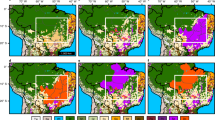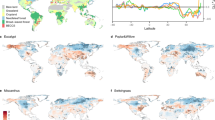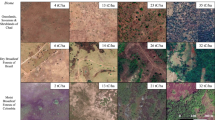Abstract
The increasing global demand for biofuels will require conversion of conventional agricultural or natural ecosystems. Expanding biofuel production into areas now used for agriculture reduces the need to clear natural ecosystems, leading to indirect climate benefits through reduced greenhouse-gas emissions and faster payback of carbon debts1. Biofuel expansion may also cause direct, local climate changes by altering surface albedo and evapotranspiration2, but these effects have been poorly documented. Here we quantify the direct climate effects of sugar-cane expansion in the Brazilian Cerrado, on the basis of maps of recent sugar-cane expansion and natural-vegetation clearance combined with remotely sensed temperature, albedo and evapotranspiration over a 1.9 million km2 area. On a regional basis for clear-sky daytime conditions, conversion of natural vegetation to a crop/pasture mosaic warms the cerrado by an average of 1.55 (1.45–1.65) °C, but subsequent conversion of that mosaic to sugar cane cools the region by an average of 0.93 (0.78–1.07) °C, resulting in a mean net increase of 0.6 °C. Our results indicate that expanding sugar cane into existing crop and pasture land has a direct local cooling effect that reinforces the indirect climate benefits of this land-use option.
This is a preview of subscription content, access via your institution
Access options
Subscribe to this journal
Receive 12 print issues and online access
$209.00 per year
only $17.42 per issue
Buy this article
- Purchase on Springer Link
- Instant access to full article PDF
Prices may be subject to local taxes which are calculated during checkout



Similar content being viewed by others
References
Field, C. B., Campbell, J. E. & Lobell, D. B. Biomass energy: The scale of the potential resource. Trends Ecol. Evol. 23, 65–72 (2008).
Bonan, G. B. Forests and climate change: Forcings, feedbacks, and the climate benefits of forests. Science 320, 1444–1449 (2008).
Searchinger, T. et al. Use of US croplands for biofuels increases greenhouse gases through emissions from land-use change. Science 319, 1238–1240 (2008).
Fargione, J., Hill, J., Tilman, D., Polasky, S. & Hawthorne, P. Land clearing and the biofuel carbon debt. Science 319, 1235–1238 (2008).
Gibbs, H. K. et al. Carbon payback times for crop-based biofuel expansion in the tropics: The effects of changing yield and technology. Environ. Res. Lett. 3, 034001 (2008).
Georgescu, M., Lobell, D. B. & Field, C. B. Potential impact of US biofuels on regional climate. Geophys. Res. Lett. 36, L21806 (2009).
Georgescu, M., Lobell, D. & Field, C. Direct climate effects of perennial bioenergy crops in the United States. Proc. Natl Acad. Sci. USA 108, 4307–4312 (2011).
Olson, D. M. & Dinerstein, E. The Global 200: A representation approach to conserving the Earth’s most biologically valuable ecoregions. Conserv. Biol. 12, 502–515 (1998).
Eiten, G. The cerrado vegetation of Brazil. Bot. Rev. 38, 201–341 (1972).
LAPIG Laboratorio de Processamento de Imagens e Geoprocessamento. Programa Cerrado (Universidade Federal de Goias, 2008); available at http://www.lapig.iesa.ufg.br/lapig/.
Macedo, I. C., Seabra, J. E. A. & Silva, J. Green house gases emissions in the production and use of ethanol from sugarcane in Brazil: The 2005/2006 averages and a prediction for 2020. Biomass Bioenerg. 32, 582–595 (2008).
Fearnside, P. M. et al. Biomass and greenhouse-gas emissions from land-use change in Brazil’s Amazonian. Forest Ecol. Manag. 258, 1968–1978 (2009).
Lapola, D. M. et al. Indirect land-use changes can overcome carbon savings from biofuels in Brazil. Proc. Natl Acad. Sci. USA 107, 3388–3393 (2011).
Barona, E., Ramankutty, N., Hyman, G. & Coomes, O. T. The role of pasture and soybean in deforestation of the Brazilian Amazon. Environ. Res. Lett. 5, 024002 (2010).
Acknowledgements
This work was made possible through the support of the Stanford University Global Climate and Energy Project.
Author information
Authors and Affiliations
Contributions
S.R.L., D.B.L. and C.B.F. designed the study and conducted the analysis. Q.M. contributed data sets. S.R.L., D.B.L., C.B.F., G.P.A. and Q.M. wrote the paper.
Corresponding author
Ethics declarations
Competing interests
The authors declare no competing financial interests.
Supplementary information
Supplementary Information
Supplementary Information (PDF 1808 kb)
Rights and permissions
About this article
Cite this article
Loarie, S., Lobell, D., Asner, G. et al. Direct impacts on local climate of sugar-cane expansion in Brazil. Nature Clim Change 1, 105–109 (2011). https://doi.org/10.1038/nclimate1067
Received:
Accepted:
Published:
Issue Date:
DOI: https://doi.org/10.1038/nclimate1067
This article is cited by
-
Long-term activity of social insects responsible for the physical fertility of soils in the tropics
Scientific Reports (2023)
-
Assessment of Land Degradation in Northern Oman Using Geospatial Techniques
Earth Systems and Environment (2022)
-
The distribution, ecology and conservation status of the long-tailed woodnymph Thalurania watertonii
Ornithology Research (2022)
-
Water Consumption Modeling by Coupling MODIS Images and Agrometeorological Data for Sugarcane Crops
Sugar Tech (2021)
-
Spatiotemporal variations of albedo in managed agricultural landscapes: inferences to global warming impacts (GWI)
Landscape Ecology (2020)



